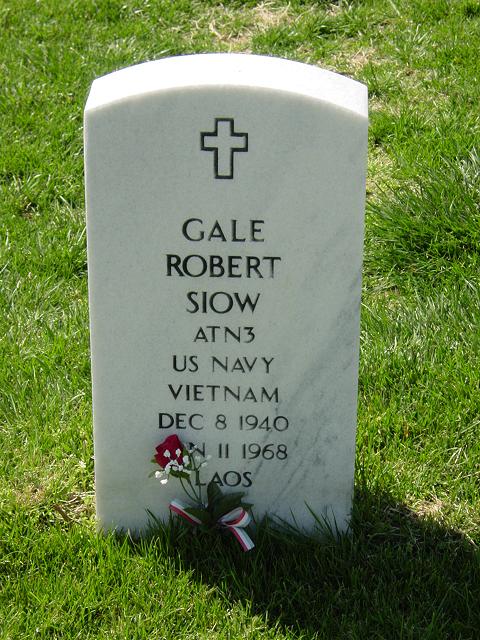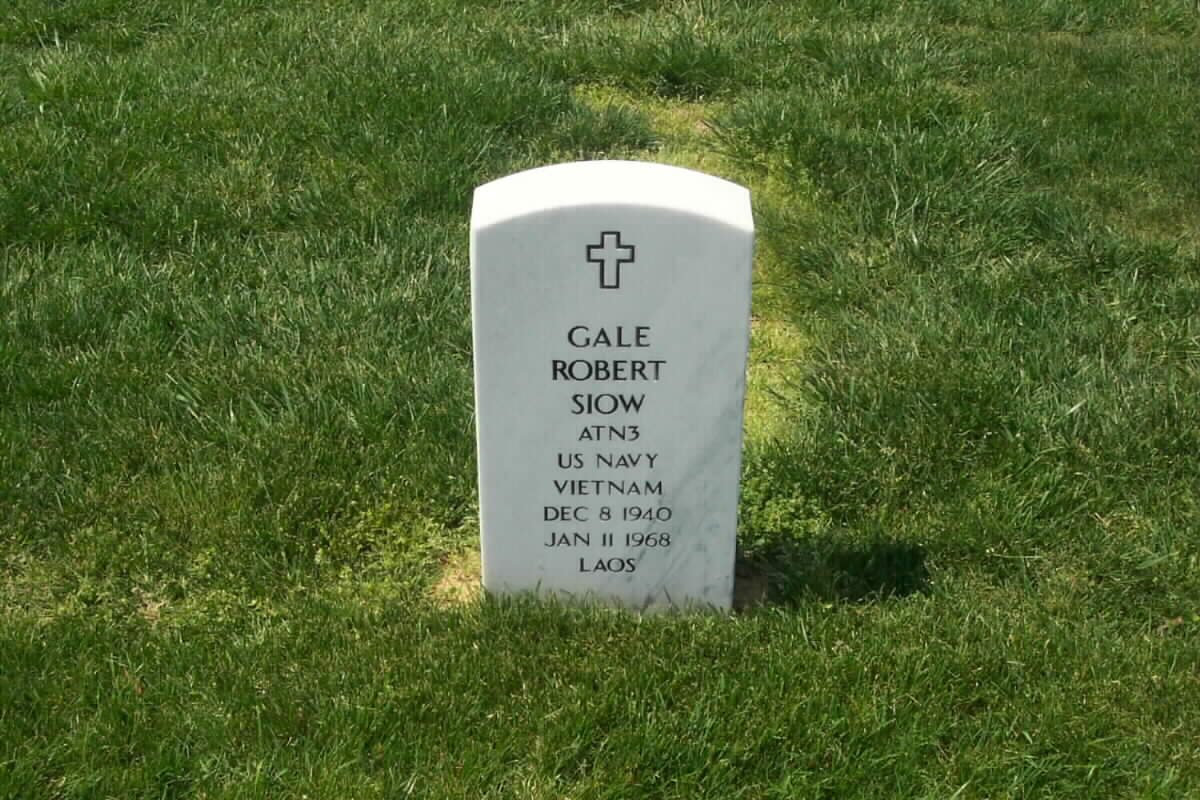From a press report: May 29, 2003
LOS ANGELES, California – The widow of a Navy petty officer who vanished during the Vietnam War says that after 35 years of uncertainty, she is looking forward to his funeral.
“This is finally a closure for us,” Rebecca J. Siow said in a telephone interview Wednesday. “He’s coming home.”
“I’m glad it happened so that we can welcome him and the crew back from oblivion,” she said.
A surveillance plane carrying Petty Officer 3rd Class Gale R. Siow of Huntington Beach and eight others vanished on January 11, 1968. It was on a mission to drop sensors in Laos to detect enemy movements.
He was classified first as missing in action and then some years ago as killed in action, but the jungle and mountain terrain near the site kept the aircraft from being recovered for more than three decades.
The Pentagon announced Tuesday that the remains had been identified. They will be buried June 18 at Arlington National Cemetery.
Mrs. Siow, 60, and her two surviving children will be there.
Mrs. Siow, now of San Jose, said she learned from officials about a year ago that her husband was dead. For decades, she said, she never accepted it.
“Everything was in suspension for me. I kind of functioned day by day,” she said. “I figured he was missing in action or maybe a prisoner…. I didn’t believe that they were dead.”
Siow was born in Albuquerque, New Mexico, to a Hopi Indian mother and a father who was a member of the Laguna tribe, his widow said.
He grew up in Arizona and attended Tempe University for a semester or two before moving to California, where he eventually settled in Huntington Beach.
He was working in the accounting department of an insurance company when he decided to follow his two eldest brothers and join the Navy.
“He was making good money there but it was getting a little hectic for him,” Mrs. Siow said.
He became a radio and electronics man for Navy airplanes.
Siow met his wife at a YMCA dance while she was living in San Francisco and he was stationed at nearby Moffett Field. They married in September 1962.
He loved his Navy job and planned to make it a career, his widow said, adding that he sometimes talked about opening an electronics shop after retiring from the service.
“He was a very gentle person,” his widow said. “He liked his work. He liked working on airplanes.”
Siow often was away from home on various assignments but when he left on his final mission, Mrs. Siow said, she never doubted he would return.
“He knew it was dangerous,” she said. “He mentioned that he … had a feeling that he wouldn’t come back.
“Of course, I couldn’t imagine that. He always came home.”
According to the Pentagon, the plane carrying Siow left a Thailand base. In its last radio transmission, the crew reported descending through dense clouds in Laos.
Siow left two sons and a daughter.
Two weeks after the plane went down, an Air Force crew photographed what was believed to have been the crash site, but enemy activity in the area prevented a recovery operation, a Pentagon statement said.
Investigators interviewed villagers near the site and found debris on two ledges of Phou Louang mountain in Khammouan province of Laos, the statement said. The teams recovered identification cards for several crew members during a 1996 visit. Other visits yielded human remains and other identifying items from the wreckage.
The years were hard for her, Mrs. Siow said.
“I actually was dealing with depression,” she said. “A lot of times I couldn’t bring myself to come home. Even though we bought a house and it was nice and all, I would ride in the car with the kids and we would go all over the place. We went to parks or to the beach.”
“So many lost years there,” she said. “We just functioned, barely.”
She never remarried and now lives with her son Sean, 37, in San Jose. Another son, Robert, 40, is in nearby Sunnyvale.
Her daughter, Elizabeth, died of liver and kidney failure in February. She was 38. Before her death, however, she had learned that her father’s remains had been identified and would be returned.
“I think once it is behind us I’ll be able to function,” Mrs. Siow said. “I always wanted the case to close.
“I just knew that Gale had to come home.”
May 29, 2003
LOS ANGELES – The widow of a Navy petty officer who vanished during the Vietnam War says that after 35 years of uncertainty, she is looking forward to his funeral.
“This is finally a closure for us,” Rebecca J. Siow said in a telephone interview Wednesday. “He’s coming home.”
“I’m glad it happened so that we can welcome him and the crew back from oblivion,” she said.
A surveillance plane carrying Petty Officer 3rd Class Gale R. Siow of Huntington Beach and eight others vanished on January 11, 1968. It was on a mission to drop sensors in Laos to detect enemy movements.
He was classified first as missing in action and then some years ago as killed in action, but the jungle and mountain terrain near the site kept the aircraft from being recovered for more than three decades.
The Pentagon announced Tuesday that the remains had been identified. They will be buried June 18 at Arlington National Cemetery.
Mrs. Siow, 60, and her two surviving children will be there.
Mrs. Siow, now of San Jose, said she learned from officials about a year ago that her husband was dead. For decades, she said, she never accepted it.
“Everything was in suspension for me. I kind of functioned day by day,” she said. “I figured he was missing in action or maybe a prisoner…. I didn’t believe that they were dead.”
Siow was born in Albuquerque, N.M., to a Hopi Indian mother and a father who was a member of the Laguna tribe, his widow said.
He grew up in Arizona and attended Tempe University for a semester or two before moving to California, where he eventually settled in Huntington Beach.
He was working in the accounting department of an insurance company when he decided to follow his two eldest brothers and join the Navy.
“He was making good money there but it was getting a little hectic for him,” Mrs. Siow said.
He became a radio and electronics man for Navy airplanes.
Siow met his wife at a YMCA dance while she was living in San Francisco and he was stationed at nearby Moffett Field. They married in September 1962.
He loved his Navy job and planned to make it a career, his widow said, adding that he sometimes talked about opening an electronics shop after retiring from the service.
“He was a very gentle person,” his widow said. “He liked his work. He liked working on airplanes.”
Siow often was away from home on various assignments but when he left on his final mission, Mrs. Siow said, she never doubted he would return.
“He knew it was dangerous,” she said. “He mentioned that he … had a feeling that he wouldn’t come back.
“Of course, I couldn’t imagine that. He always came home.”
According to the Pentagon, the plane carrying Siow left a Thailand base. In its last radio transmission, the crew reported descending through dense clouds in Laos.
Siow left two sons and a daughter.
Two weeks after the plane went down, an Air Force crew photographed what was believed to have been the crash site, but enemy activity in the area prevented a recovery operation, a Pentagon statement said.
Investigators interviewed villagers near the site and found debris on two ledges of Phou Louang mountain in Khammouan province of Laos, the statement said. The teams recovered identification cards for several crew members during a 1996 visit. Other visits yielded human remains and other identifying items from the wreckage.
The years were hard for her, Mrs. Siow said.
“I actually was dealing with depression,” she said. “A lot of times I couldn’t bring myself to come home. Even though we bought a house and it was nice and all, I would ride in the car with the kids and we would go all over the place. We went to parks or to the beach.”
“So many lost years there,” she said. “We just functioned, barely.”
She never remarried and now lives with her son Sean, 37, in San Jose. Another son, Robert, 40, is in nearby Sunnyvale.
Her daughter, Elizabeth, died of liver and kidney failure in February. She was 38. Before her death, however, she had learned that her father’s remains had been identified and would be returned.
“I think once it is behind us I’ll be able to function,” Mrs. Siow said. “I always wanted the case to close.
“I just knew that Gale had to come home.”
NOTE: For additional information on this crew, please click here.
Michael Robert Patterson was born in Arlington and is the son of a former officer of the US Army. So it was no wonder that sooner or later his interests drew him to American history and especially to American military history. Many of his articles can be found on renowned portals like the New York Times, Washingtonpost or Wikipedia.
Reviewed by: Michael Howard



